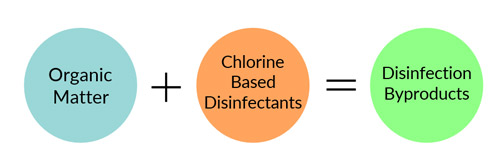Drinking water is only one of the possible routes of exposure to lead contamination, but it is one of the easiest routes of contamination to reduce. The primary route for lead poisoning in drinking water is not old contamination of the water by leaded fuels, old batteries or some hazardous waste site, the primary route is the distribution system used to carry water to your home and more importantly the plumbing within your home. That is right: YOUR household plumbing may be the cause for lead in your drinking water. In older homes, lead was used to make the piping and/or solder. In homes, built prior to 1930’s water pipes were primarily made from lead. These pipes can be identified because the piping tends to have a dull gray color, can be scratched with a key, and a magnet will not stick to the piping. In buildings built between the 1930’s and early 1980’s, copper pipes were often used, but the solder contained elevated levels of lead. This does not mean that a newer home is safe from lead contamination; in fact, the available data suggests that buildings less than 5 years old can have high levels of lead. In fact, buildings built prior to 1986 likely contain some lead plumbing. Prior to 2014, the legal definition for "lead free" was plumbing fixtures with a lead content of less than 8 %. In 2014, the term was redefined to include only fixtures with a lead content of 0.25% and newly installed fixtures must use the "lead free" materials, but this did not apply to fixtures currently in use.



 Alpha Analytical Laboratories performs bioassay according to 40 CFR 136, currently the “Methods for Measuring the Acute Toxicity of Effluents and Receiving Waters to Freshwater and Marine Organisms,” 5th Edition (EAP-821-R-02-012). This acute toxicity of effluent limits will be evaluated by measuring survival of rainbow trout species exposed to 96-hour static renewal bioassays. We also offer LC-50 Polsini & Miller methodology to determine if solid or aqueous matrices should be characterized as hazardous material. The fathead minnow species are used in both screening and definitive applications.
Alpha Analytical Laboratories performs bioassay according to 40 CFR 136, currently the “Methods for Measuring the Acute Toxicity of Effluents and Receiving Waters to Freshwater and Marine Organisms,” 5th Edition (EAP-821-R-02-012). This acute toxicity of effluent limits will be evaluated by measuring survival of rainbow trout species exposed to 96-hour static renewal bioassays. We also offer LC-50 Polsini & Miller methodology to determine if solid or aqueous matrices should be characterized as hazardous material. The fathead minnow species are used in both screening and definitive applications. 
 Let Alpha provide full service support for your storm water permit’s monitoring. Our laboratories provide the full suite of analyses along with consulting partnerships specializing in SWPPP, regulatory guidance and onsite field assistance.
Let Alpha provide full service support for your storm water permit’s monitoring. Our laboratories provide the full suite of analyses along with consulting partnerships specializing in SWPPP, regulatory guidance and onsite field assistance.